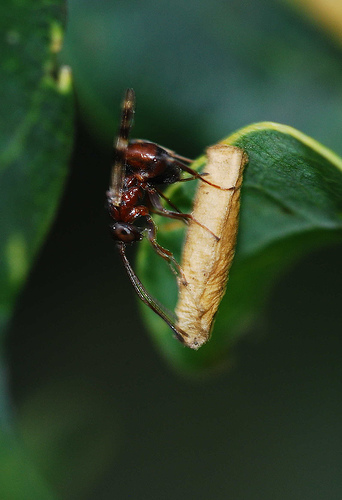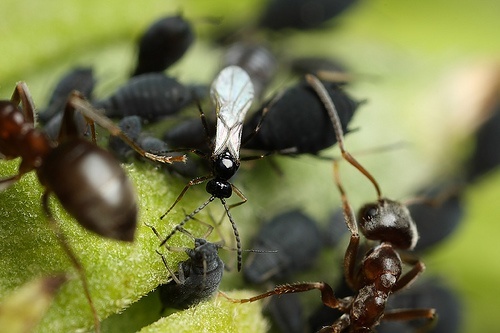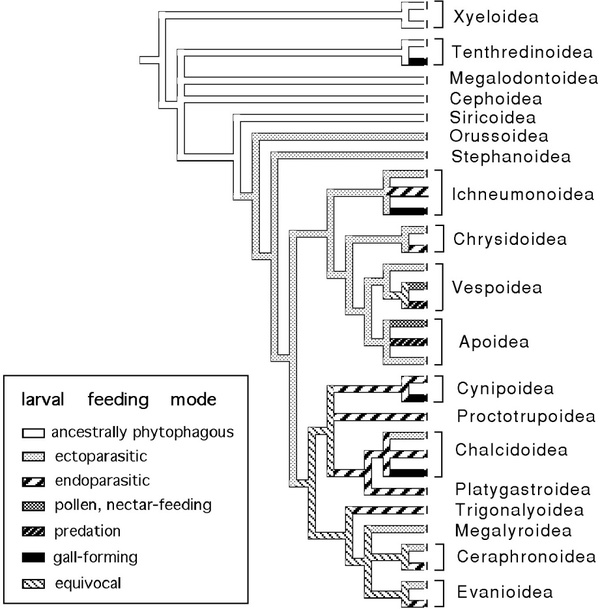| << Chapter < Page | Chapter >> Page > |
Understanding the evolution of parasitoid wasps is essential to explaining the observed diversity of relationships between parasitoid wasps and their hosts. The interactions between parasitoids and hosts are primarily controlled by genetic factors. Therefore in order to understand the occurrence of parasitoid diversity we must trace the evolutionary history of these organisms by considering the ecological constraints that affect parasitoid development and the observed physiological traits parasitoids use to infest other organisms (Pennacchio and Strand, 2006). This paper will focus on the evolution of the parasitoid lifestyle, ecological constraints that shape parasitoid development, methods of host location and oviposition, and the physiological tools parasitoid wasps use to regulate their hosts.
Hymenopteran insects first appear in the fossil record around 220 million years ago and the first parasitoids appear around 160 million years ago (Whitfield, 1998). The evolution of hymenopteran insects paralleled that of plants and other insects. As angiosperms became increasingly diversified, the Hymenoptera underwent substantial radiation such that all the major lineages of Hymenoptera present today exist by 65 million years ago (Whitfield, 1998).
Recent studies of hymenopteran phylogeny have used comparative morphology and DNA sequencing to provide a thorough understanding of this order (Whitfield, 1998). Phylogenetic hypotheses have since been formulated to investigate the evolution of various parasitoid lifestyles. Current evidence indicates that parasitism evolved once in a common ancestor of the Orrussoidea and Apocrita . After the occurrence of the original life history transition, many developmental strategies that facilitate parasitism have evolved independently multiple times (Whitfield, 1998).


Orrussoids and several basal apocritan lineages share biological habits and developmental strategies, tending to be ectoparasitic idiobionts of beetles. Thus, the ancestral parasitoid was most likely an ectoparasitic idiobiont that lived on concealed wood-boring beetle larvae (Wharton, 1993). Developmental strategies evolved after the original appearance of ectoparasitic idiobionts. The Ichneumonoidea is divided into the Braconidae and Ichneumonidae. While most ectoparasitic ichneumonoids are idiobonts that develop on concealed hosts, a few groups, such as the Polysphinctini, are koinobionts that parasitize mobile hosts such as spiders (Shaw, 1994). Many aculeates are ectoparasitic idiobionts or have evolved closely related developmental strategies. Novel habits such as pollination, predation, and sociality also evolved in the aculeates (Whitfield, 1998).

| SuborderSuperfamily | Estimated number of species | Biological habits and developmental strategies |
| Symphyta | ||
| Xyeloidea | 60 | Phytophagous as immature |
| Megalodontoidea | 300 | Phytophagous as immatures |
| Tenthredinoidea | 7,000 | Phytophagous as immatures, some gallformers, some predators as adults |
| Cephoidea | 100 | Stem-boring herbivores as immatures |
| Siricoidea | 200 | Phytophagous and mycophagous as immatures |
| Orussoidea | 70 | Idiobiont ectoparasitoids of beetles(Buprestidae) |
| Apocrita | ||
| Stephanoidea | 100 | Idiobiont ectoparasitoids of wood-boringbeetles and wasps |
| Megalyroidea | 100 | Ectoparasitic idiobionts of beetles |
| Trigonalyoidea | 100 | Parasitoids oviposit on plants. Eggs eaten byLepidoptera but only develop if lepidopteranlarva is parasitized and thus developendoparasitically, possibly ashyperparasitoids |
| Aculeata | 92,000 | Basal lineages idiobiont ectoparasitoids. Nestprovisioning with adults providing multipleprey to offspring that feed as ectoparasitoidsalso common. Other species are predators orpollin/nectar feeders; many social species |
| Evanioidea | 1,200 | Ectoparasitic idiobionts or cleptoparasites(Gasteruptiidae), endoparasitic koinobionts ofbeetles (Aulacidae), or egg predators(Evaniidae) |
| Ceraphronoidea | 2,000 | Both ectoparasitic and endoparasitic; biologypoorly known |
| Ichneumonoidea | 100,000 | Basal lineages ectoparasitic idiobionts;multiple origins of endoparasitic koinobionts;polydnaviruses associated with selectedadvanced lineages |
| Chalcidoidea | 100,000 | Extremely diverse habits that includeectoparasitism, endoparasitism, predation,gall formation, seed feeding, and other formsof phytophagy |
| Platygastroidea | 10,000 | Endoparasitic idiobionts of eggs (Scelionidae)or endoparasitic koinobionts of larvae(Platygastridae) |
| Cynipoidea | 4,000 | Basal lineages of endoparasitic koinobiontsthat complete their development asectoparasitoids. Derived lineages includeendoparasitic koinobionts (Figitidae) or gallformers (Cynipidae) |
| Proctotrupoidea | 6,000 | Endoparasitic koinobionts of diverse hosts |
| Total | 280–320,000 | More than 75% of known species areparasitoids |

Notification Switch
Would you like to follow the 'Mockingbird tales: readings in animal behavior' conversation and receive update notifications?